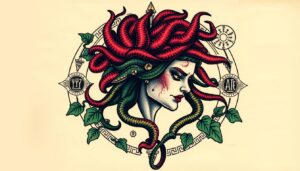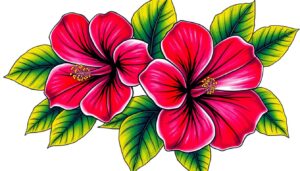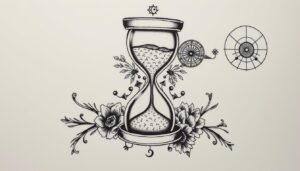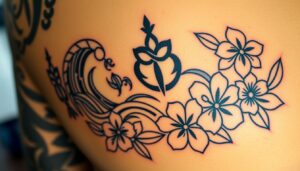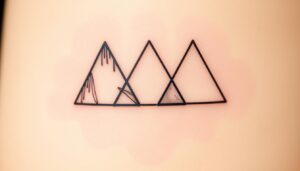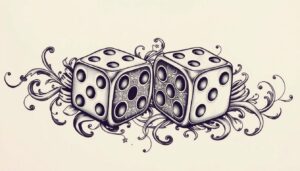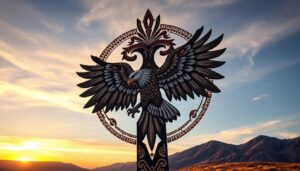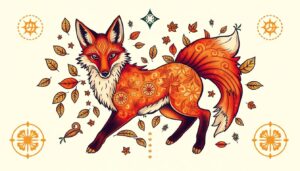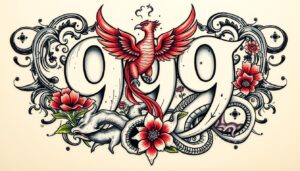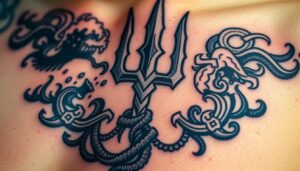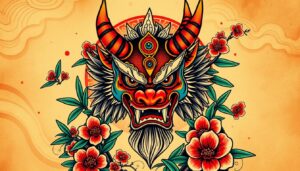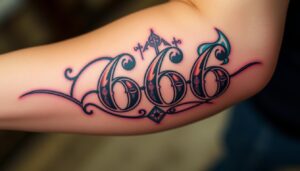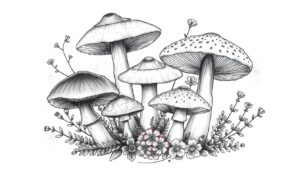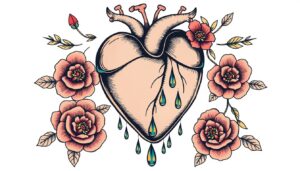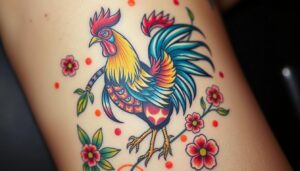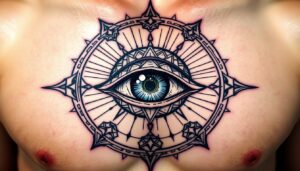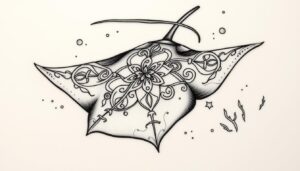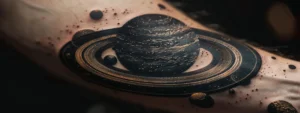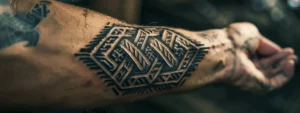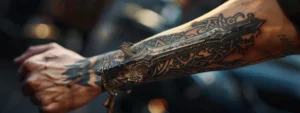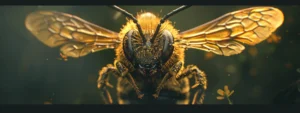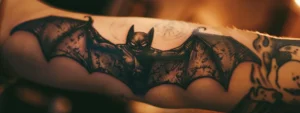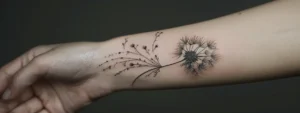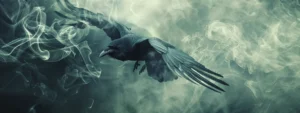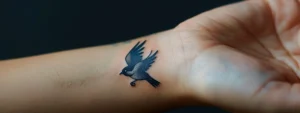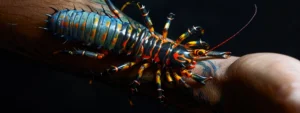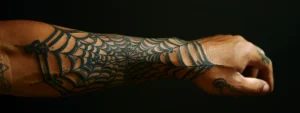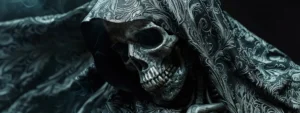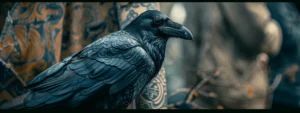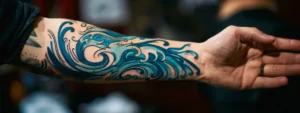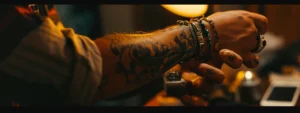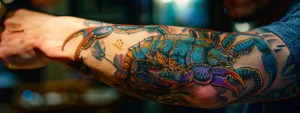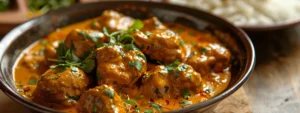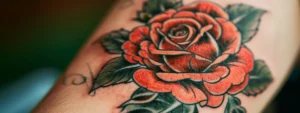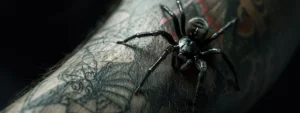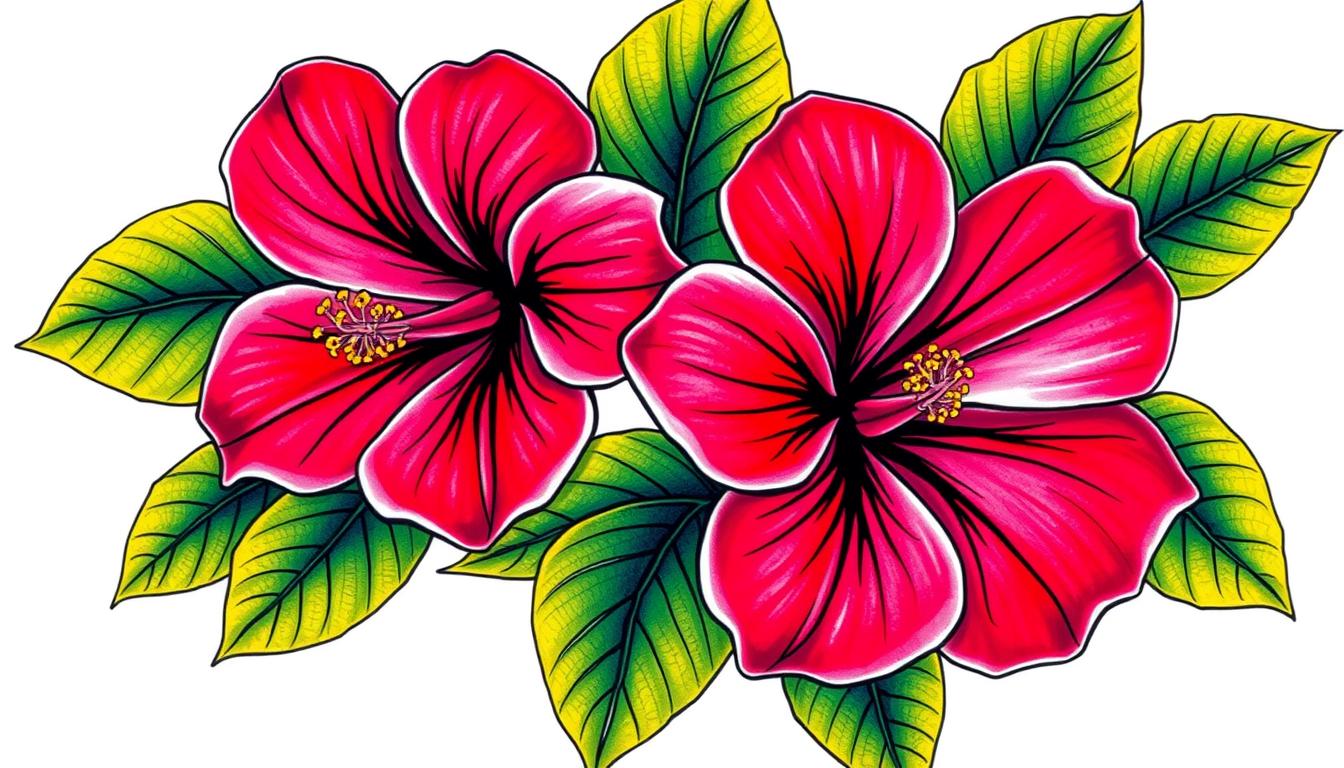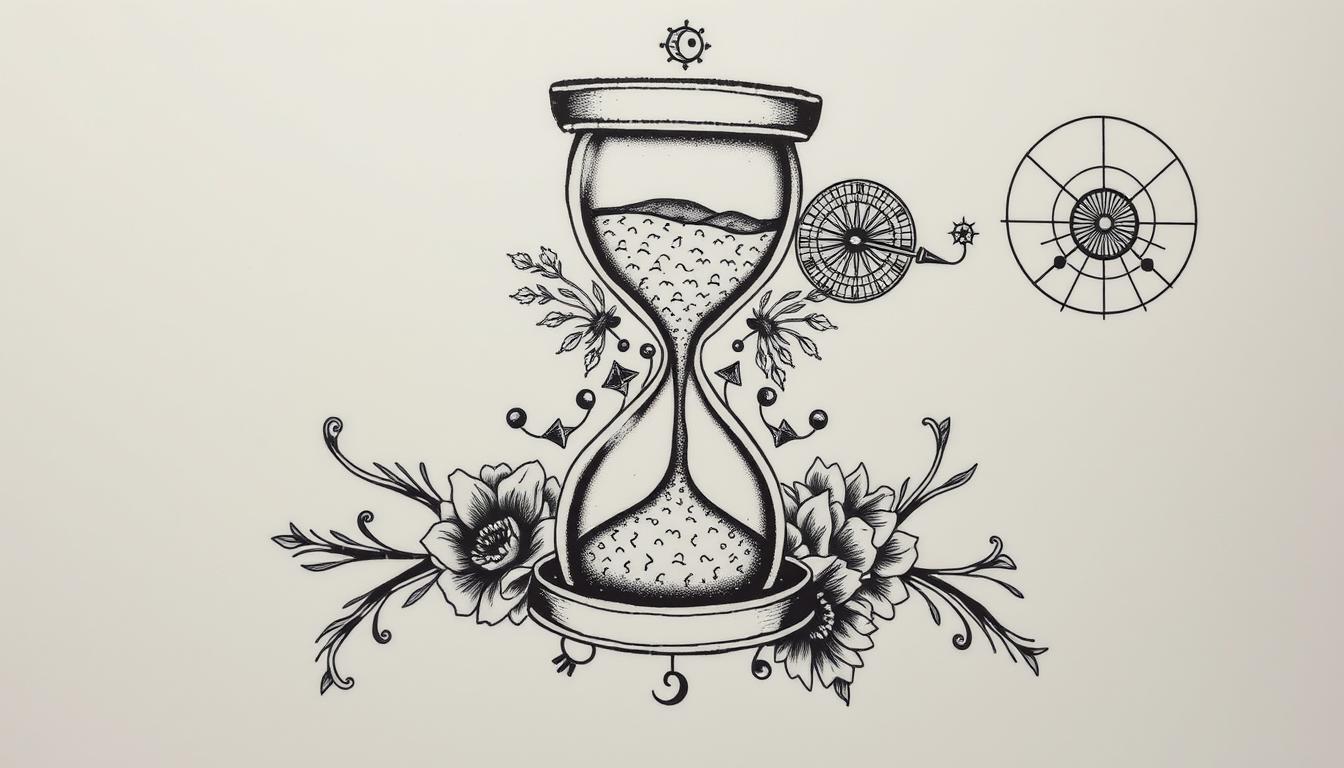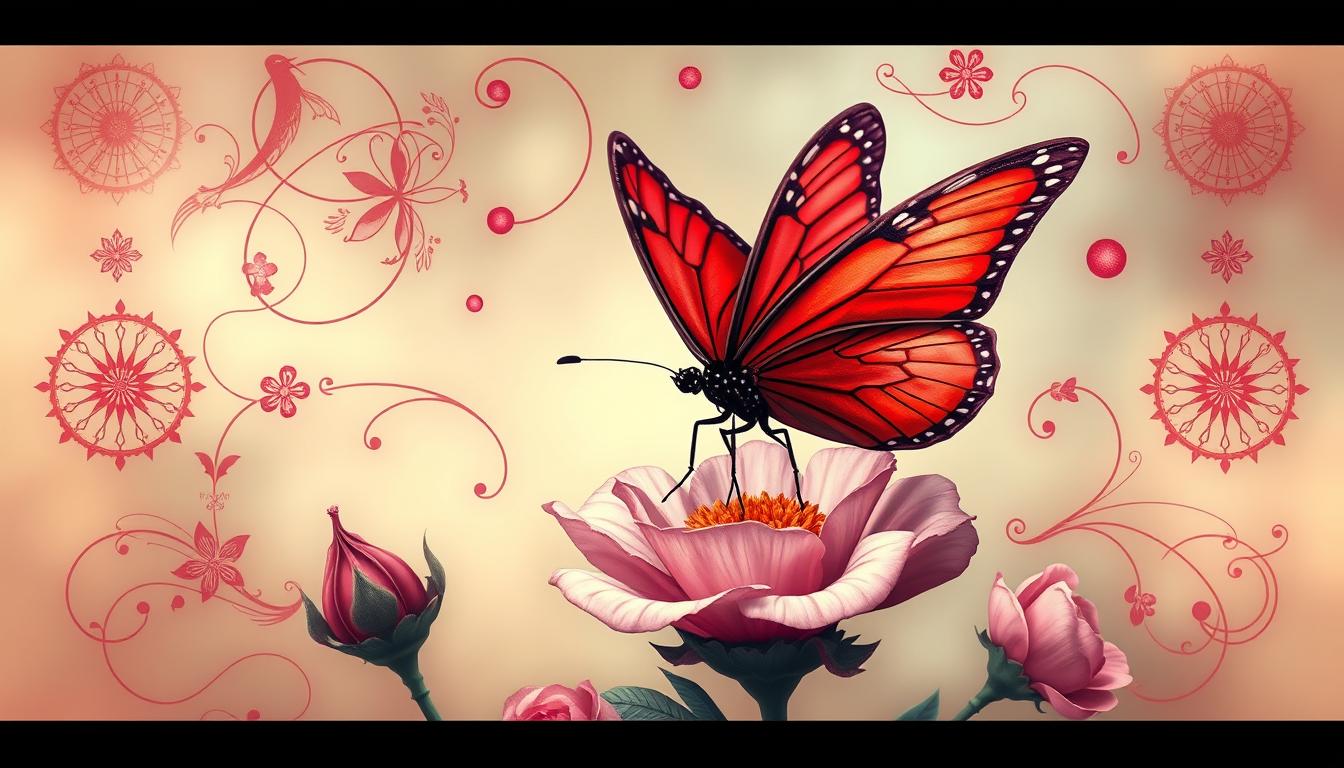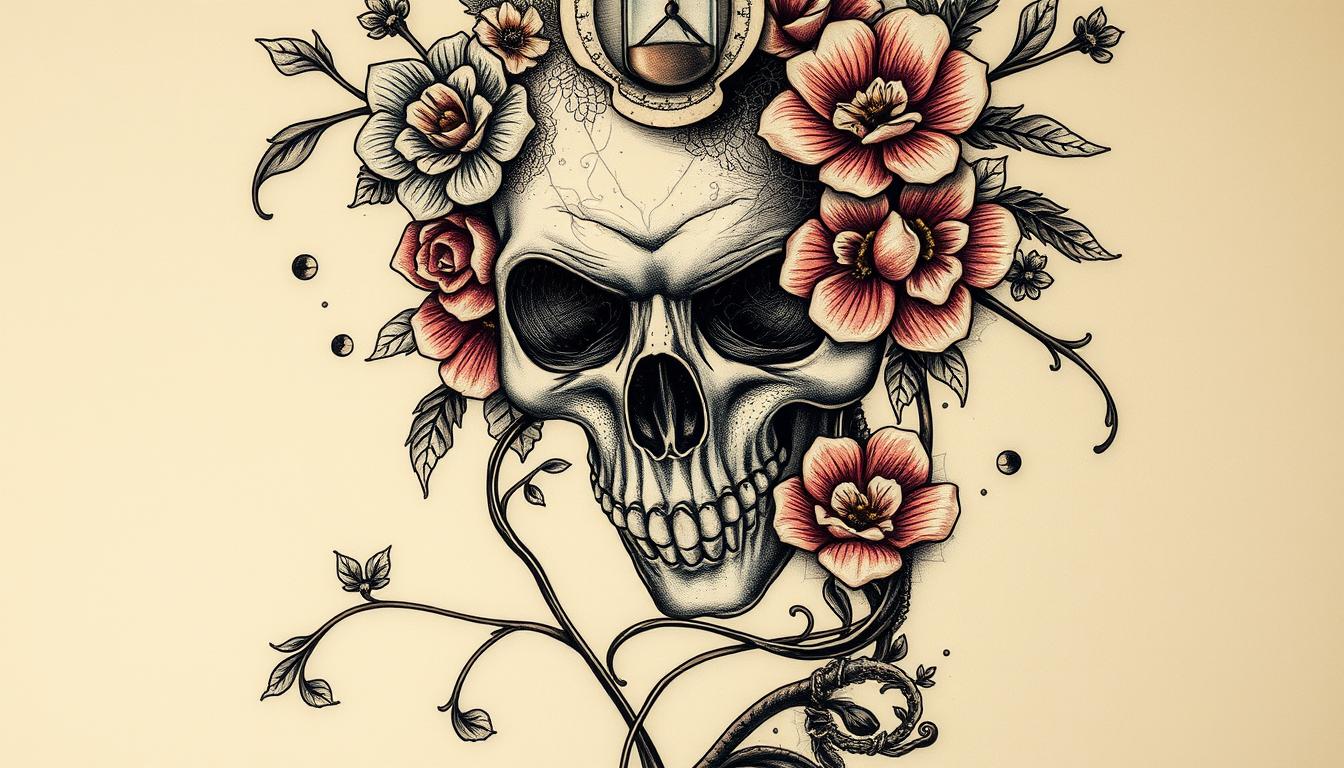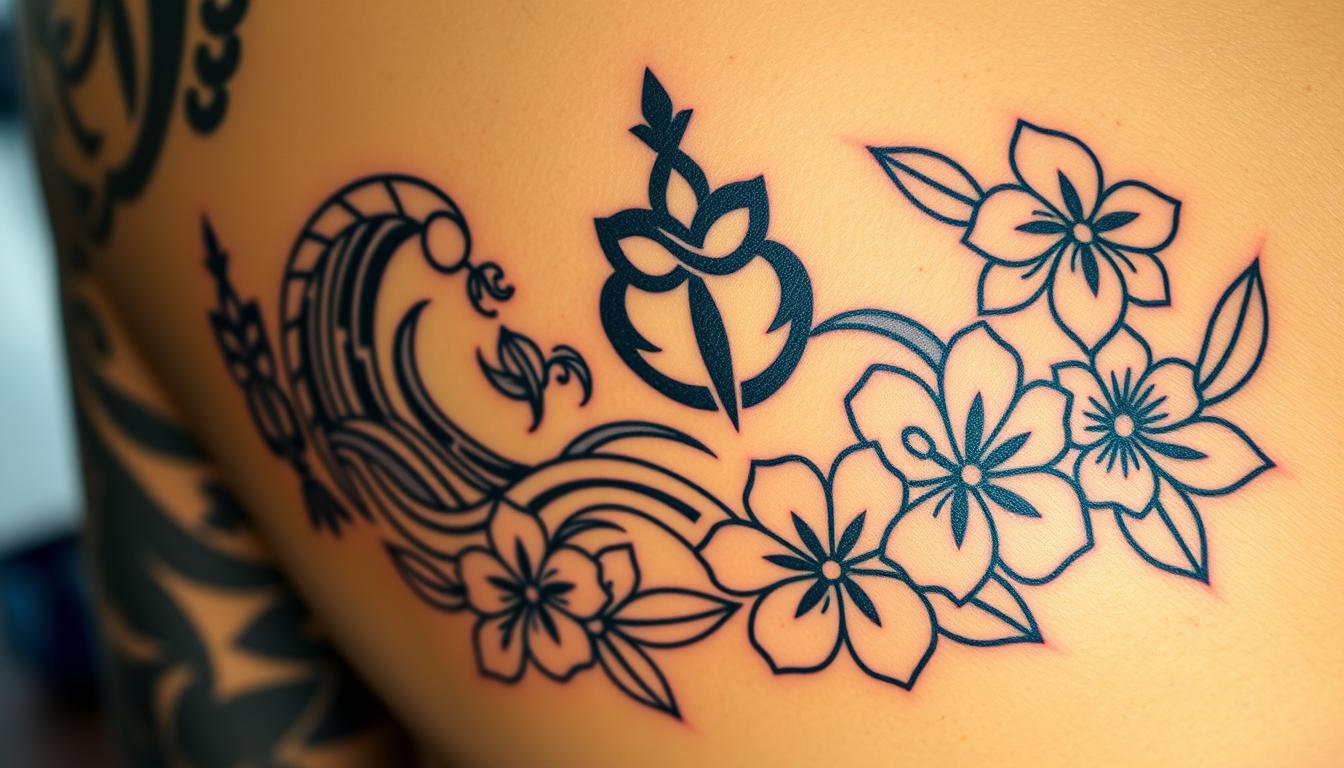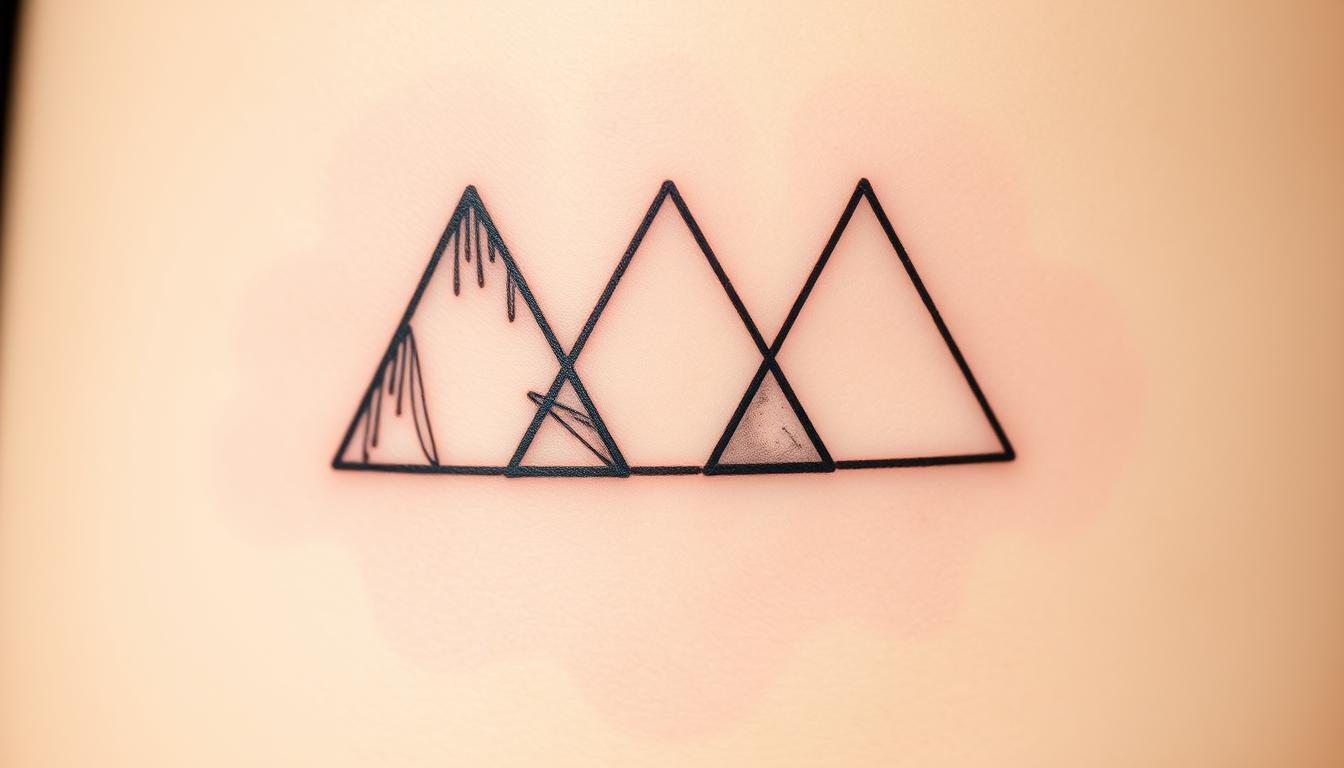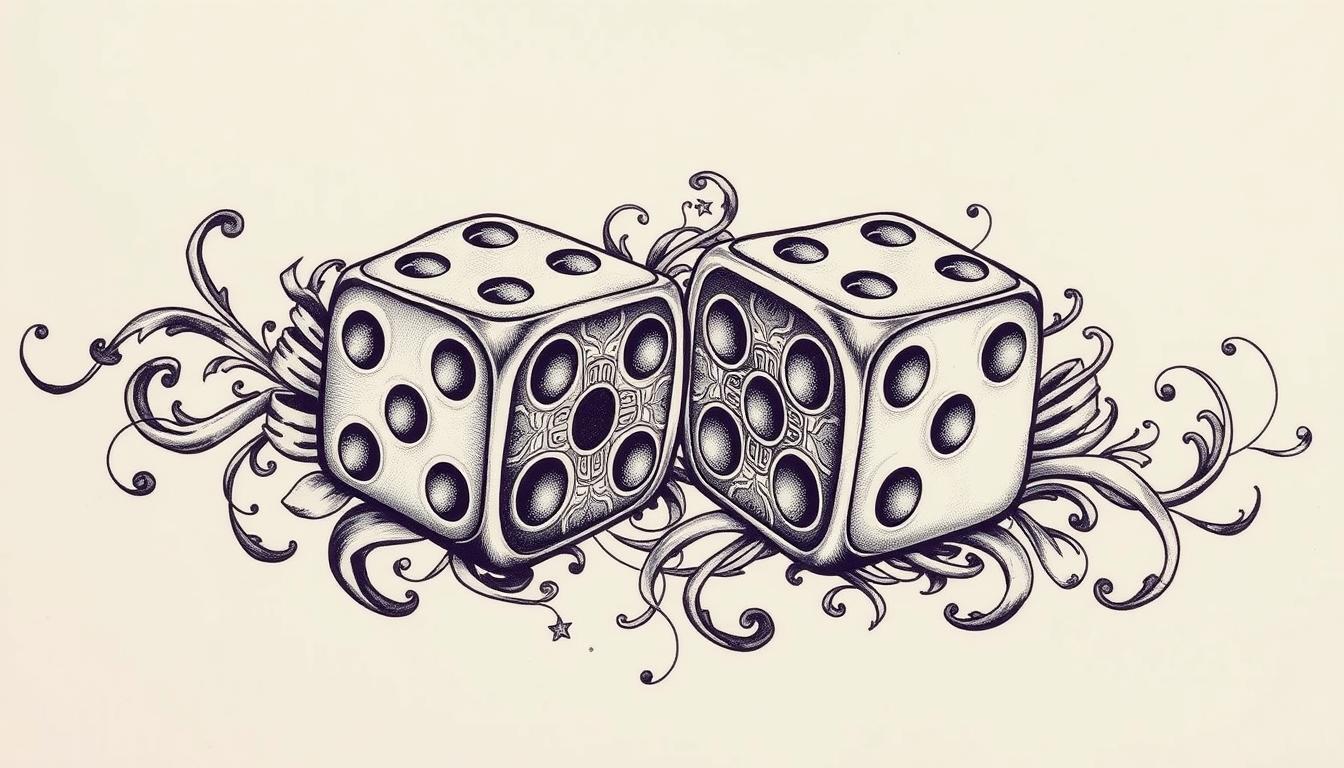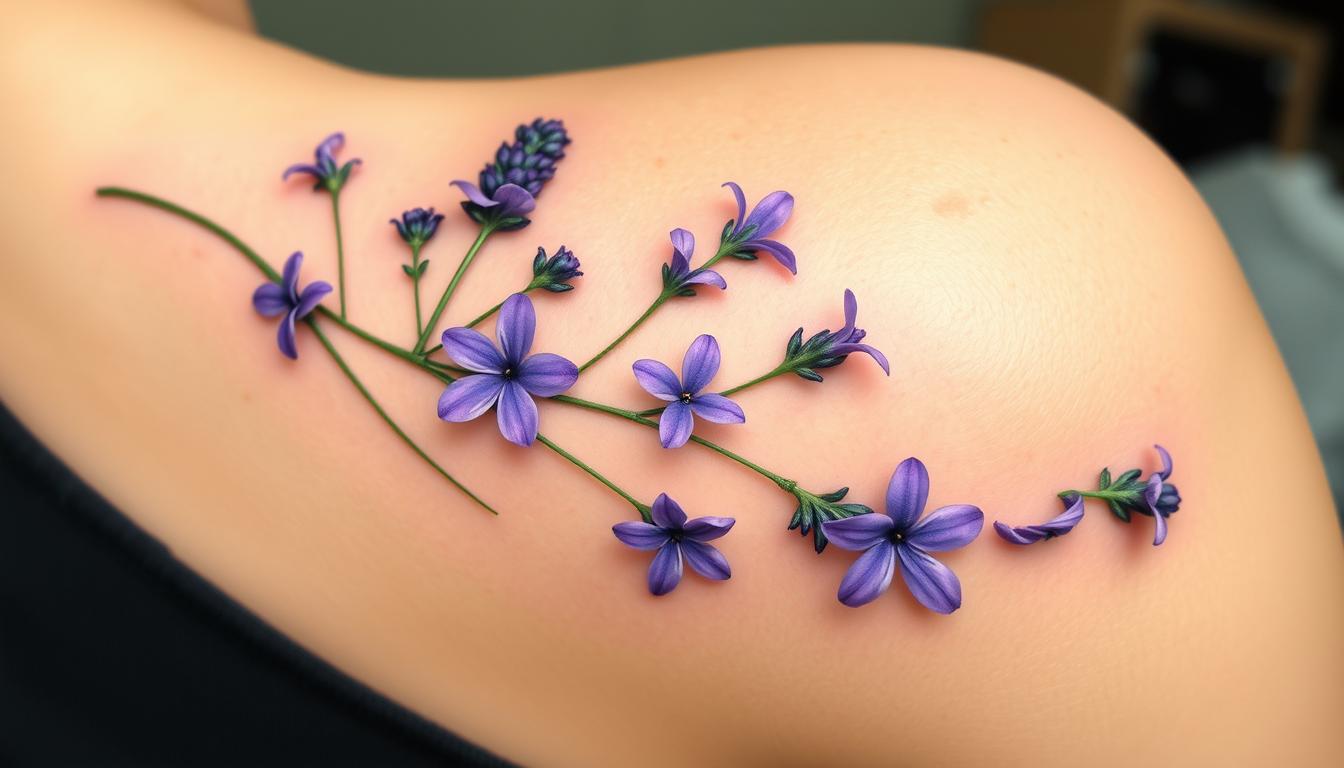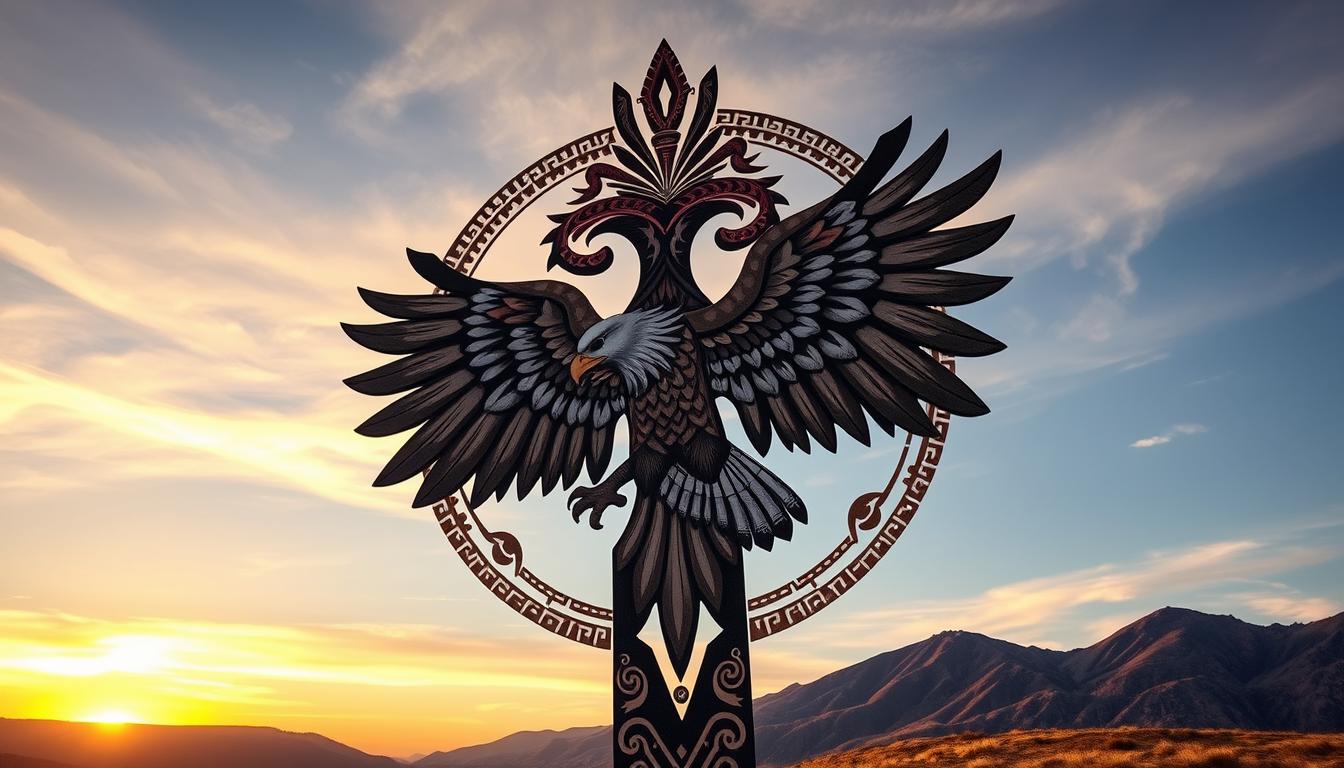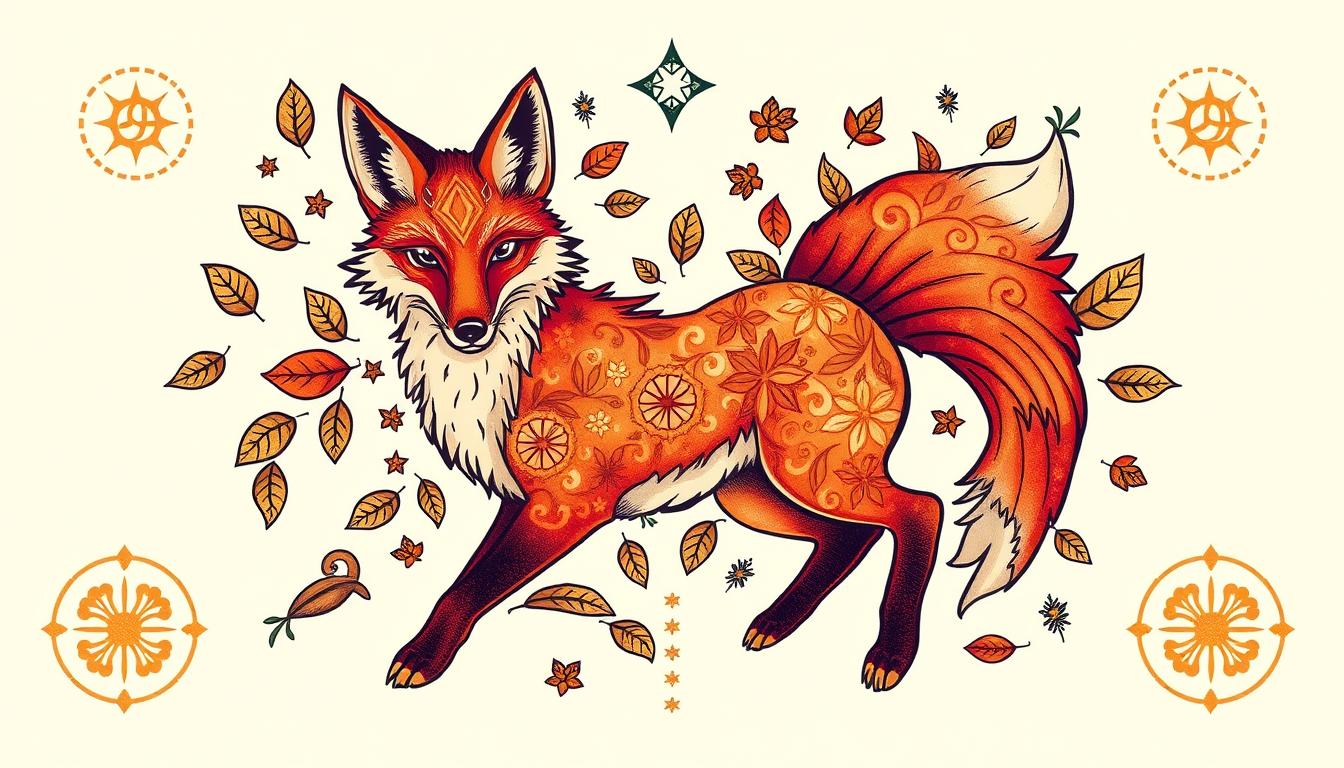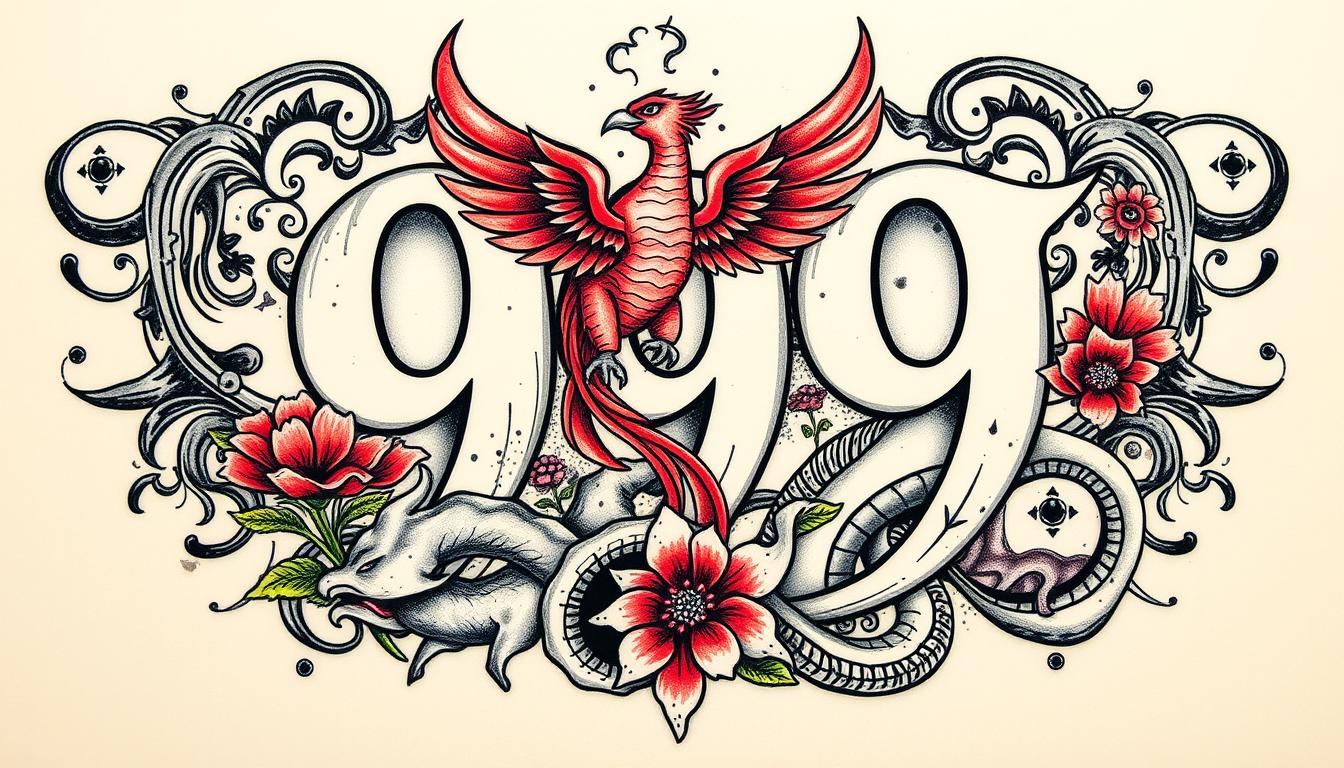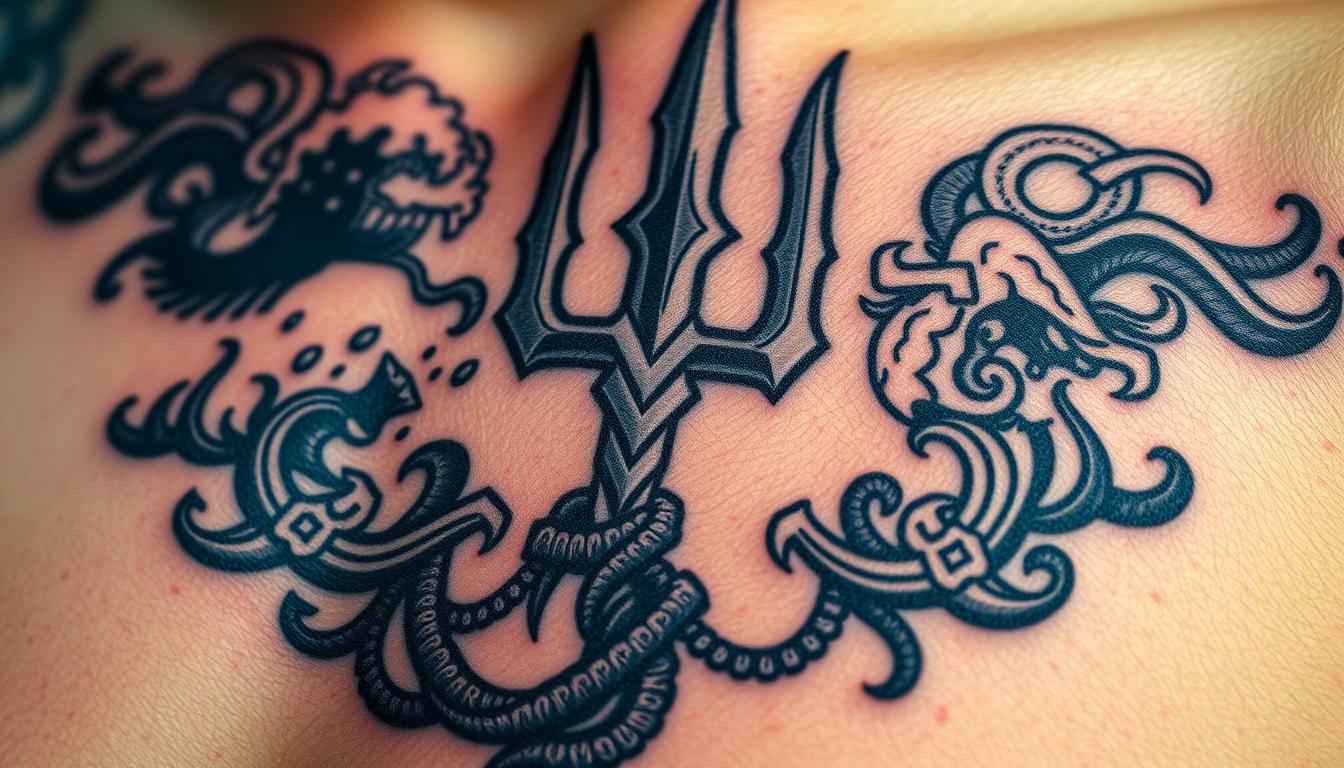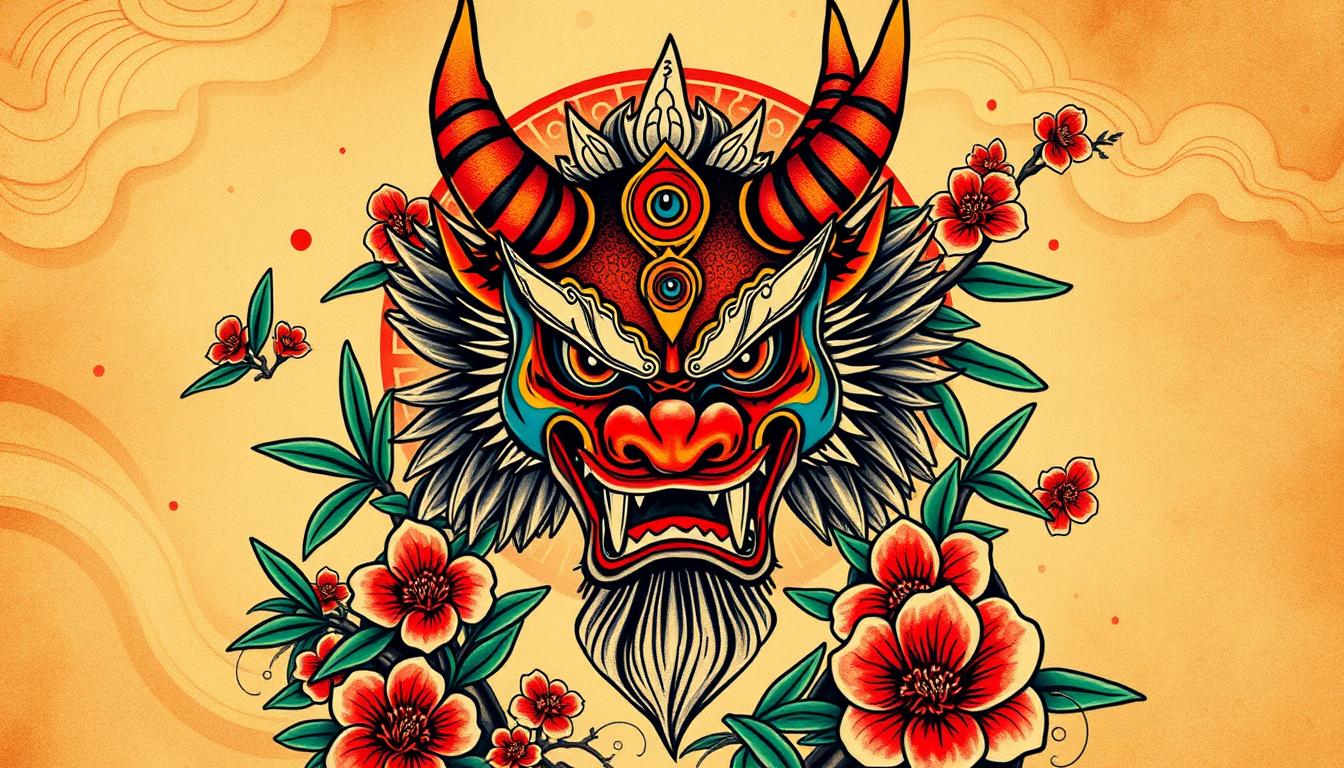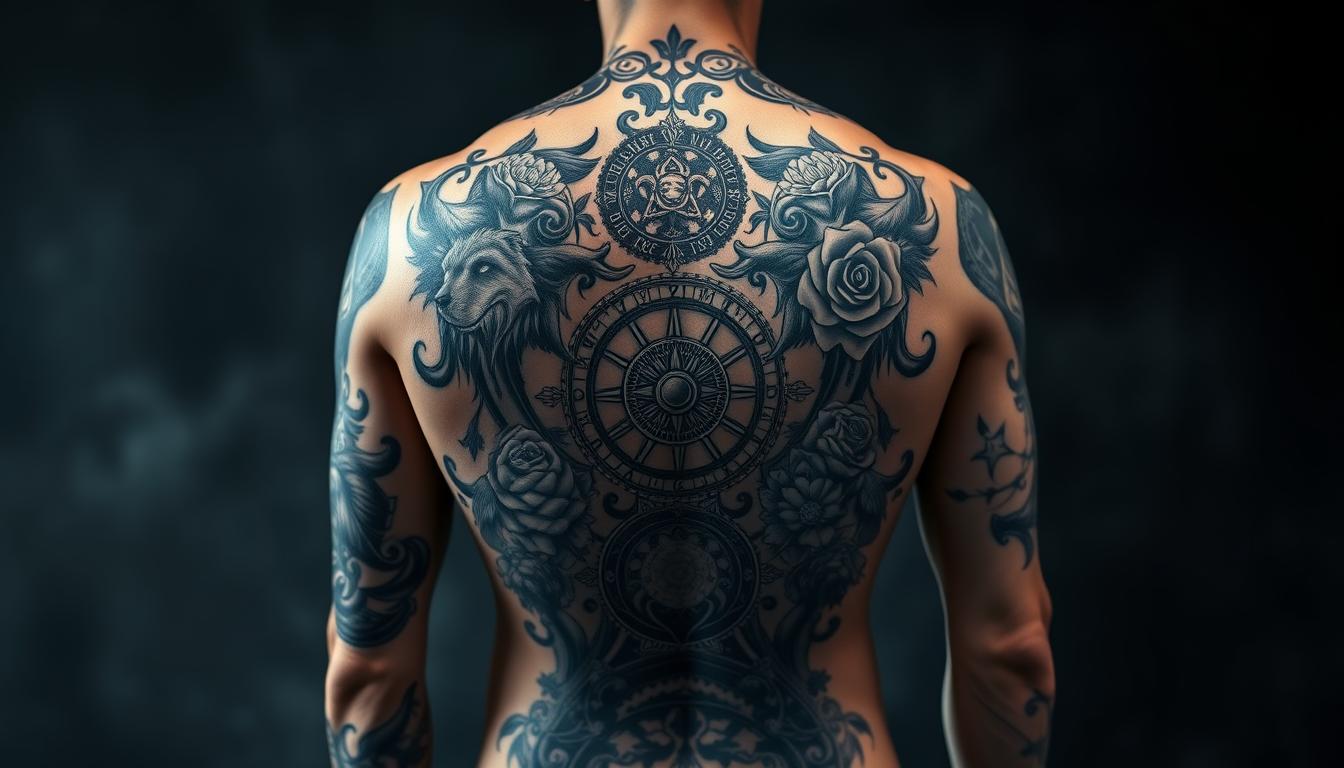Hawaiian tattoos, or kakau, are more than just body art. They are a deep connection to family, tradition, and the spiritual world. Each design has its own meaning, showing who the person is, their status, and their family history.
After being suppressed during colonial times, Hawaiian tattoos are now back in style. Both men and women are getting these tattoos to share their stories, beliefs, and dreams. They see it as a way to connect with their heritage through Polynesian body art.
Key Takeaways
- Hawaiian tattoos are deeply rooted in Polynesian culture, representing family, tradition, and spiritual connection.
- Each tattoo design carries profound symbolic meaning, reflecting the wearer’s identity, status, and ancestral lineage.
- The traditional Hawaiian tattoo practice faced suppression but has experienced a revival in recent years.
- Both men and women are embracing Hawaiian tattoos to express their beliefs, struggles, and desires.
- The resurgence of Hawaiian tattoos has led to a renewed appreciation for the rich symbolism and variety of designs in this style.
Understanding Hawaiian Family Tattoo Heritage
Hawaiian family tattoos, known as mo’okūʻauhau, have deep roots in ancient Polynesian body art traditions. These intricate designs documented family history, social status, and achievements. They preserved ancestral legacy through generations.
Origins of Hawaiian Family Body Art
The art of Hawaiian family tattoos comes from Polynesian settlers in the Hawaiian Islands. These early Hawaiians brought a rich cultural heritage, including kākau, the traditional tattooing technique. Through this art, families recorded their lineage, significant events, and spiritual beliefs on their bodies.
Cultural Significance Through Generations
Hawaiian family tattoos have been significant for centuries. Each symbol carries meanings of kinship, strength, and protection. These tattoos were not just for show; they represented identity, ancestral roots, and connection to the land and the divine.
Traditional Methods of Application
Applying Hawaiian family tattoos was a traditional process. It used tools like uhi (bone or wood chisels) and moli (wooden mallets). The ink, made from kukui (candlenut) tree soot, was applied carefully. This process was painful and long. Today, while modern methods are used, the cultural and ancestral significance remains strong.
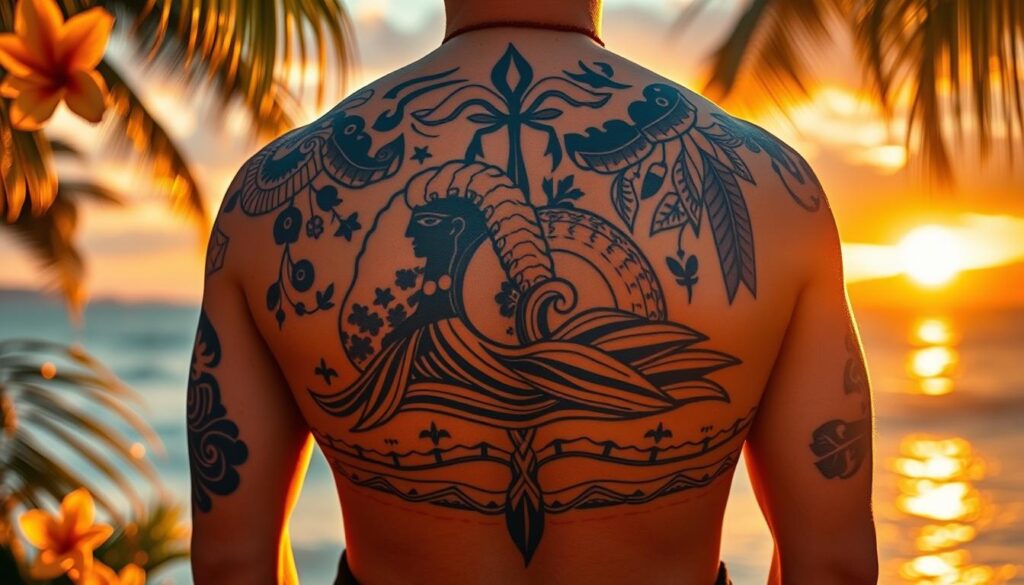
“The only Hawaiian who has received the honor of conducting the traditional art of tattooing or kākau ceremony is Kahuna Kā Uhi (Uhi Master), Keli’i Makua. Makua studied under another master, Keoni Nunes, for over 20 years before taking on the role himself, indicating a significant apprenticeship period in this traditional art form.”
The Sacred Connection Between Family and Hawaiian Tattoos
Hawaiian tattoos are deeply meaningful for families, creating a strong bond across generations. They are more than just tattoos; they symbolize ‘ohana, the Hawaiian word for family. They show how all living beings are connected.
The tapa’au, a braided cord, is a key symbol in Hawaiian family tattoos. It represents the unity and tradition of the clan. It shows that every family member is a vital part of a larger whole, connected by their shared heritage.
The kapua’i, or footprint, is another important symbol. It stands for the presence and guidance of ancestors. This symbol shows that ancestors are always with us, guiding us on our life’s path.
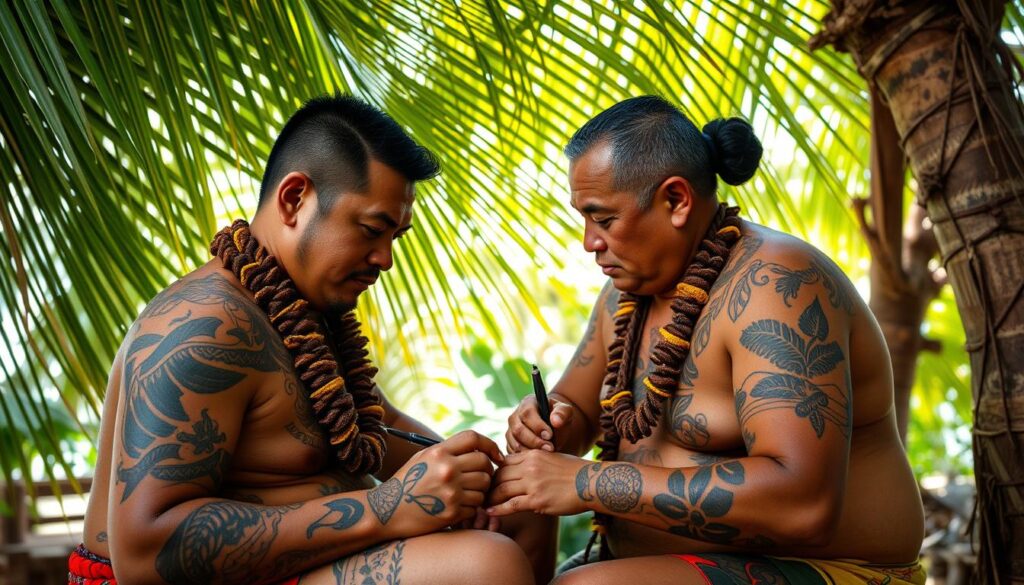
“Hawaiian tattoos create a sacred bond between family members and ancestors, representing the concept of ‘ohana’ and the interconnectedness of all living things.”
These tattoos are more than just decorations; they reflect the cultural and spiritual values of the Hawaiian people. By wearing these tattoos, individuals show their connection to their family and ancestors. They honor the traditions and values passed down through generations.
The bond between family and Hawaiian tattoos shows the strength and resilience of Hawaiian culture. These ancient art forms are still loved and kept alive today. They connect us to the past and celebrate the strong bonds of the Hawaiian ‘ohana.
Family Hawaiian Tattoo Meanings in Modern Culture
The world is getting closer, and Hawaiian tattoo designs now reflect modern family experiences. These tattoos keep ancient meanings but also add new twists. This mix of old and new lets families stay connected to their heritage and today’s world.
Contemporary Interpretations
Today’s Hawaiian tattoo artists blend old and new styles. Young people are using their family’s history to tell their own stories. This way, they keep their roots alive while showing who they are today.
Preserving Ancient Symbolism
The deep meanings of Hawaiian tattoos stay true to their roots. Symbols like the turtle and shark still mean protection and strength. Families keep these symbols alive, passing them down to future generations.
Bridging Past and Present
Hawaiian family tattoos connect the old and the new. They let people honor their family while also showing who they are. These tattoos are a way to express oneself, bring families together, and celebrate their culture.
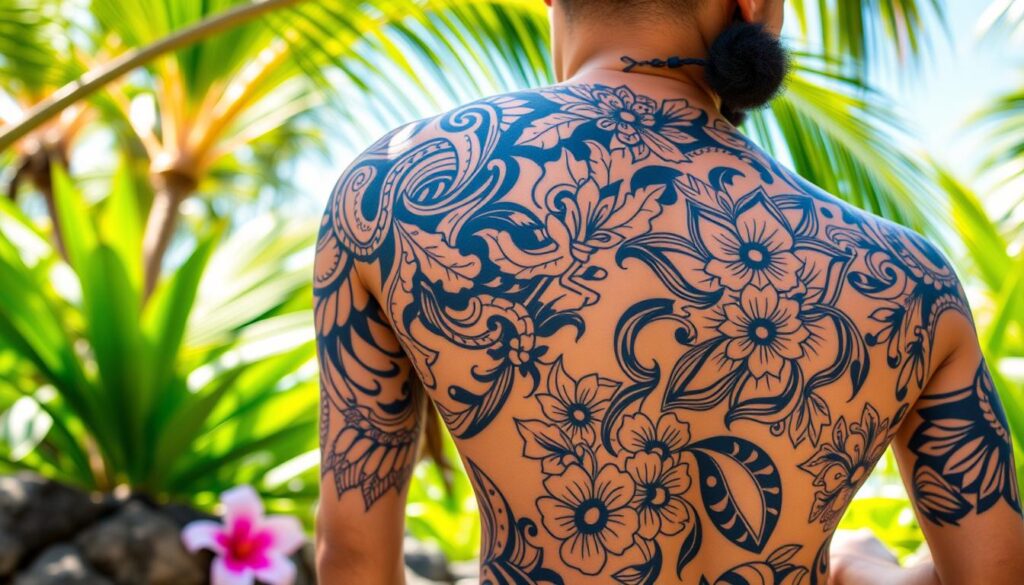
“Hawaiian tattoos are a living, breathing art form that connect the past, present, and future of our people. They are a testament to the resilience and adaptability of our cultural traditions.”
– Kailani Akina, renowned Hawaiian tattoo artist
Turtle (Honu) Symbolism in Family Tattoos
In Hawaiian and Polynesian cultures, the turtle, known as the Honu, is very important in family tattoos. It stands for endurance, health, long life, good luck, prosperity, and unity. These creatures are also seen as navigators, guiding the Polynesians to the Hawaiian Islands.
The Honu tattoo design is common in these cultures. It symbolizes protection, resilience, family, and harmony with nature. Sea turtles, like the Honu, have been in the oceans for millions of years. This shows their endurance and longevity.
Family and community values are key in Hawaiian and Polynesian cultures. Sea turtles show dedication to their offspring, reflecting these values.
Customizing a Honu turtle tattoo is possible, allowing for personal touches like names and dates. Working with a skilled tattoo artist is important to create a design that truly represents the individual’s story.
“The Polynesian turtle (Honu) is a symbol of family in Polynesian designs, as turtles are associated with health, fertility, long life, foundation, and peace – qualities that are highly valued in family units.”
The Honu turtle tattoo is a timeless symbol in Hawaiian and Polynesian polynesian tattoo symbolism and hawaiian tattoo cultural significance. It is a cherished way to express family identity, connection, and legacy.
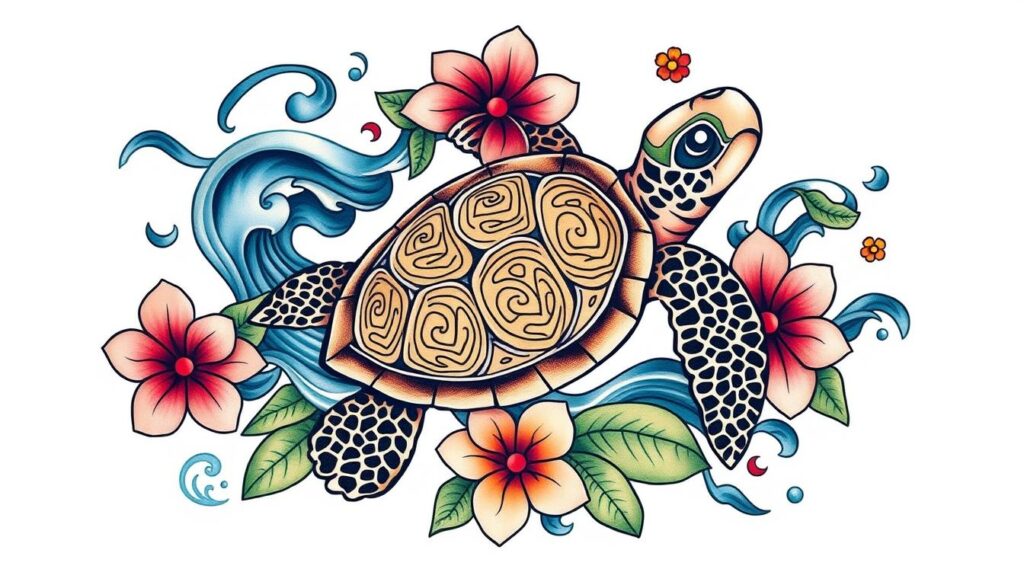
The Role of Aumakua in Family Tattoo Designs
In Hawaiian culture, aumakua, or spiritual guardian animals, are key in family tattoos. These animals, like sharks and turtles, represent a family’s ancestors. They are believed to protect and guide the family.
Spiritual Guardian Animals
The aumakua are thought to be the spirits of ancestors. They offer wisdom and protection to their families. Family tattoos with these animals show a strong bond to heritage and the belief in their guardianship.
Family Protection Symbols
- Hawaiian stories tell of ʻaumakua like ʻalalā (crow) and manō (shark).
- Every family is believed to have at least one ʻaumakua. Some families, like Mary Kawena Pukui’s, have many.
Adding aumakua to tattoos means believing in their protective power. It shows a connection to ancestral wisdom and nature. This is a big part of native hawaiian body art and hawaiian ancestral tattoos.
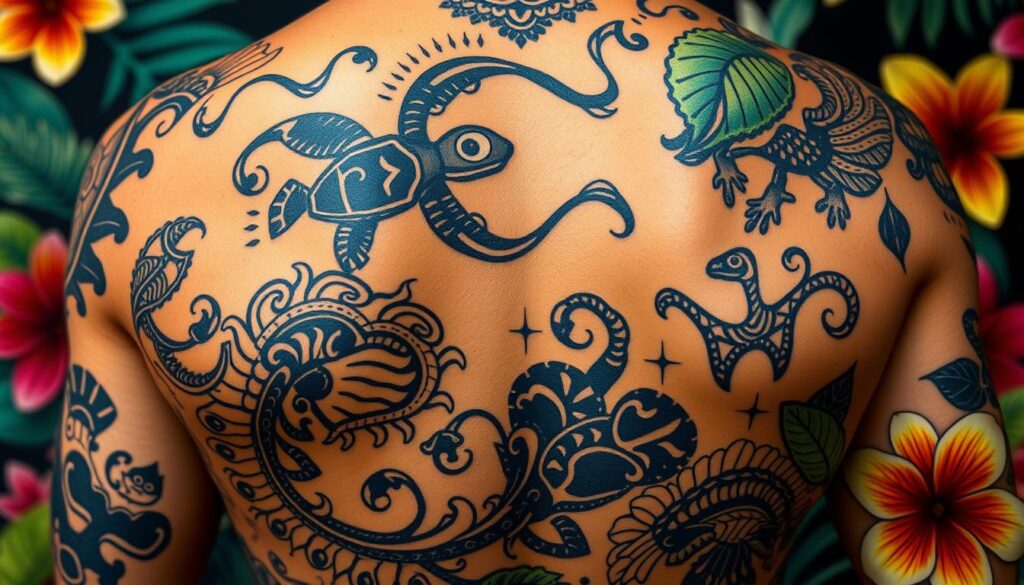
Traditional Placement and Body Positioning
In the world of tribal hawaiian tattoos and traditional hawaiian tattoo designs, where you put the tattoo matters a lot. The Polynesian people, including Hawaiians, see a deep link between our bodies and the spiritual world.
The upper body is for tattoos that show our spiritual side and connection to the heavens. For example, the chest is about honor and making things right. The head is linked to wisdom and knowing things.
- But, tattoos on the lower body talk about life on earth, like being free and full of energy.
- Where you put the tattoo also shows your place in society. Some spots are for certain people or classes.
The Polynesian view of the body as a link between earth and sky is clear in these tattoos. Each spot has its own deep meaning. It shows the mix of physical, spiritual, and cultural parts of Hawaiian life.
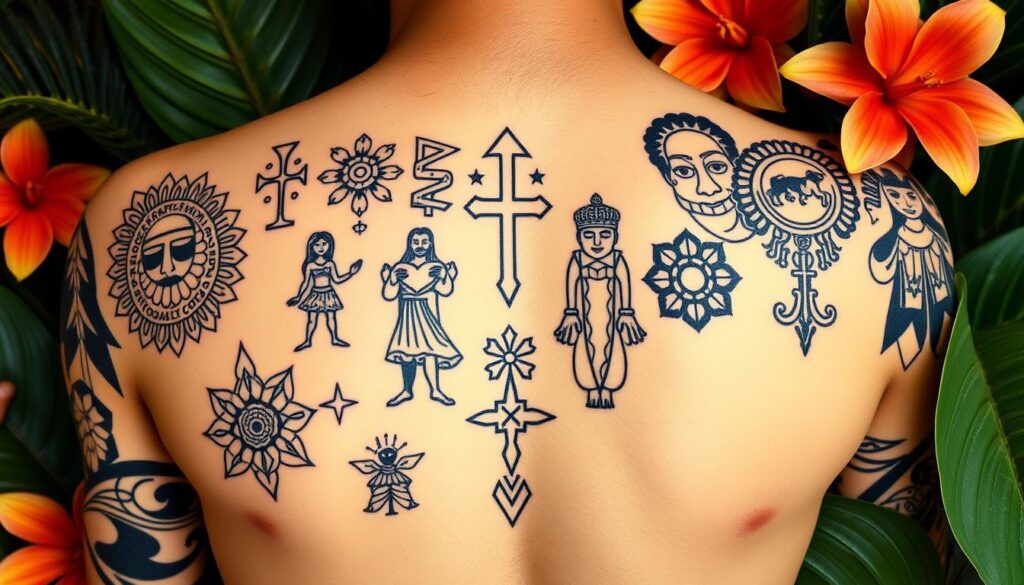
“The body is a canvas, a sacred vessel that carries the stories of our ancestors and the aspirations of our future. Each tattoo placement is a testament to the intricate balance between the earthly and the divine.”
Common Symbols in Hawaiian Family Tattoos
Hawaiian family tattoos are filled with deep meaning from Polynesian culture. The ocean wave patterns symbolize life’s flow and continuity. These designs remind us of the sea’s constant changes, linking Hawaiians across generations.
Ancestral markings are also key in these tattoos. The ani ata pattern shows ancestors with hands up, offering protection and guidance. It connects the past to the present, celebrating family ties.
The Marquesan ipu, or gourd, is another important symbol. It’s a sacred vessel for collecting the spiritual essence of ancestors. By including the ipu in tattoos, people connect with their heritage, gaining strength and wisdom from their ancestors.
| Symbol | Meaning |
|---|---|
| Ocean Wave Patterns | Represent the flow and continuity of life |
| Ani Ata | Depict rows of ancestors with uplifted hands, symbolizing protection and guidance |
| Marquesan Ipu (Gourd) | Represents a sacred container for collecting ancestors’ mana, creating a connection with them |
These symbols remind us of Hawaiians’ deep respect for their family’s heritage and ancestors.
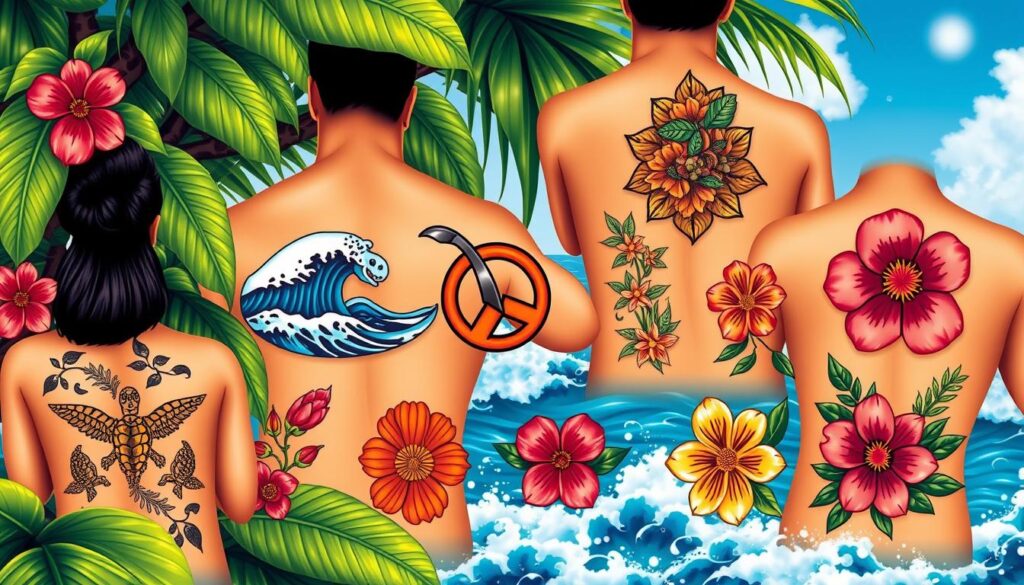
The Importance of Genealogy in Hawaiian Tattoo Art
Hawaiian family hawaiian tattoo meanings are deeply rooted in genealogy. This is a key part of the island’s culture. These hawaiian ancestral tattoos show family lineage through symbols and motifs. They connect people to their ancestors and their legacy.
Traditionally, Hawaiian tattoos, called kakau, were for men. They decorated arms, legs, torso, and even faces. These designs showed family history and social status. Women got tattoos on hands, fingers, wrists, and sometimes tongues.
Kahuna, or experts, applied these tattoos. They used bone needles and a mallet. Many tattoos honored fallen chiefs or family members. This shows how important genealogy is in Hawaiian tattoo art.
But, European settlers and Christian missionaries came in the early 19th century. They led to the decline of traditional tattoos. The loss of kahuna and the kapu system’s collapse hurt these cultural practices.
Now, Hawaii is trying to bring back its cultural heritage. Polynesian tattoos are key to this effort. Each island’s tattoos show the culture’s diversity and individuality.
Hawaiian tattoos tell stories of ancestral spirits and family history. They show achievements and community status. These tattoos are a powerful way to connect with the past.
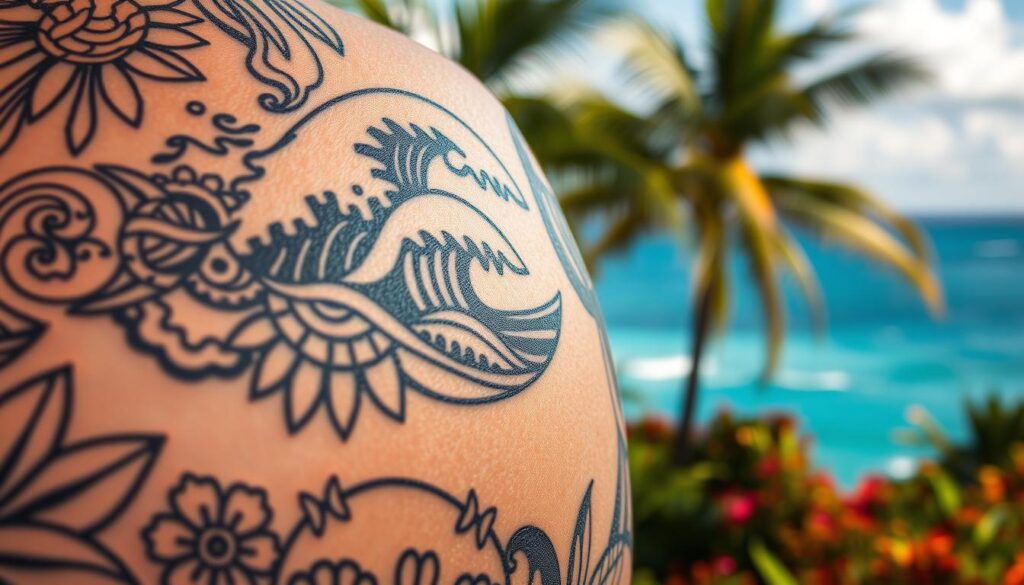
Hawaiian Family Values Expressed Through Tattoos
Hawaiian family tattoos show deep values and cultural heritage. They symbolize unity and strength, key to Hawaiian family life. The tapa’au symbol, a braided cord, represents family unity, linking generations. The niho mano (shark teeth) motif shows strength, protection, and adaptability, vital in the Hawaiian community.
These tattoos remind us of the power of family unity and support. They honor the Hawaiian tattoo cultural significance and tribal hawaiian tattoos passed down through generations. They connect us to our ancestors and our rich heritage.
Unity Symbols
The tapa’au symbol, a braided cord, shows Hawaiian family unity. It’s a visual metaphor for the strong bonds between generations. It symbolizes the strength and resilience of standing together.
Strength Representations
The niho mano (shark teeth) motif represents strength, protection, and adaptability in Hawaiian culture. These tattoos remind us of the family’s collective power and resilience. They inspire pride and identity.

“Hawaiian family tattoos are not just decorative; they are a living, breathing expression of our deepest values and beliefs. Each symbol carries a profound meaning, connecting us to our ancestors and reminding us of the strength we draw from our collective identity.”
Incorporating Personal Family Stories in Designs
Modern family hawaiian tattoo meanings often include personal stories and experiences. These designs might feature elements from important family events or memories. This way, people can honor their native hawaiian body art history while keeping traditional symbols.
One great example is adding heirloom items or special mementos to the tattoo. A family crest, an ancestral pendant, or a grandparent’s handwriting can be included. This makes the tattoo deeply personal and sentimental. It celebrates the family’s legacy and connects you to your roots.
Another way is to show important moments or milestones in the family’s story. A wedding date, the birth of a child, or a big family event can be shown through symbols or text. These details turn the tattoo into a story, telling the unique tale of the individual and their family.
| Samoan Male Tattoos | Maori Moko Kawae | Samoan Fertility Tattoos |
|---|---|---|
| Samoan male tattoos mark the moment a young man is ready to take a leading role in his family. | Maori moko kawae, the tattoo on a woman’s lips and chin, represents her family and the service she has given. | Samoan tattoos aimed at promoting fertility and appealing appearance were common. |
By adding personal family stories to their family hawaiian tattoo meanings, people can make unique and meaningful tattoos. These tattoos serve as a strong reminder of their heritage and the bond with their loved ones. This approach to native hawaiian body art design strengthens the connection to cultural identity and honors the family’s journey.
The Significance of Color in Family Tattoos
Traditional Hawaiian tattoos were mainly black. But today, they can include bright colors. Each color has its own meaning, making family tattoos even more special. Knowing the colors’ meanings helps create tattoos that honor your family’s heritage.
The color blue stands for the ocean and sky. It shows our connection to nature and our spiritual path. Green colors remind us of Hawaii’s lush landscapes. They symbolize growth, life, and the strong ties within families.
| Color | Symbolic Meaning |
|---|---|
| Blue | Ocean, sky, spiritual connection |
| Green | Nature, growth, family strength |
| Red | Courage, passion, life force |
Red is a bold color for courage, passion, and life. Using these colors in tattoos makes them personal and meaningful. They show respect for your family’s history and values.
“The use of color in Hawaiian family tattoos allows us to express the depth of our connection to the land, the sea, and the generations that came before us.”
Colors in family tattoos add to their emotional and symbolic value. Choosing colors that mean something to you makes your tattoo beautiful and meaningful. It shows your family’s story and cultural identity.
Modern Adaptations of Traditional Family Patterns
Hawaiian tattoo traditions are evolving, mixing old cultural heritage with new ideas. Artists are keeping the spirit of ancient hawaiian tattoo traditions alive. They add their own twist and style to the designs.
Contemporary Design Elements
Today’s Hawaiian family tattoos include modern touches. You’ll see geometric shapes, detailed images, and new takes on classic symbols. These elements blend old and new beautifully.
Fusion Styles
The meanings of hawaiian tattoos have grown, leading to fusion styles. Hawaiian designs meet other cultural traditions. This mix honors the past and lets people express their unique stories.
Modern Hawaiian family tattoos are a mix of old and new. They use Polynesian patterns, detailed lines, and bright colors. This blend keeps the tradition alive while showing the present.
“The essence of Hawaiian tattoo traditions lies not only in the preservation of ancient symbols but also in the ability to adapt and evolve, reflecting the changing needs and perspectives of the modern world.”
| Traditional Hawaiian Tattoos | Modern Hawaiian Tattoos |
|---|---|
| Focused on ancestral symbols and cultural heritage | Blend traditional motifs with contemporary design elements |
| Utilized natural inks and hand-tapping techniques | Incorporate a wider range of materials and application methods |
| Followed strict protocols and spiritual rituals | Allow for more individual expression and personalization |
| Primarily adorned the body as a means of cultural identification | Serve as both cultural symbols and personal expressions of identity |
Sacred Geometry in Hawaiian Family Tattoos
Hawaiian family tattoos are deeply meaningful, thanks to sacred geometry. The Marquesan Cross, a key symbol, shows balance between elements and harmony. Triangular patterns represent the balance between life’s physical, spiritual, and emotional sides.
These designs are the base for complex family tattoos. They show the connection of Hawaiian people and their heritage. Hawaiian tattoo artists use these symbols to create meaningful art that celebrates family and heritage.
The patterns in Hawaiian family tattoos are not just pretty. They carry deep cultural and spiritual meaning. Symbols like the Marquesan Cross and triangles tell stories of values and traditions passed down through generations.
Understanding these tattoos’ sacred geometry helps us appreciate Hawaiian culture and family bonds. These tattoos are a symbol of Hawaiian strength and resilience, whether on the body or as family heirlooms.
| Symbol | Meaning |
|---|---|
| Marquesan Cross | Balance between the four elements and universal harmony |
| Triangular Patterns | Balance between the physical, spiritual, and emotional aspects of life |
Choosing the Right Family Symbol for Your Tattoo
Choosing a family symbol for a Hawaiian tattoo is a personal and meaningful journey. Traditional Hawaiian tattoos carry deep cultural significance. It’s important to think carefully about the symbols’ origins and their connection to your family’s heritage.
Personal Meaning Considerations
When picking a family symbol for your Hawaiian tattoo, think about its personal significance. Ask yourself these questions:
- What parts of your family history or lineage do you want to honor?
- Are there specific symbols or motifs passed down in your family?
- How do you want the tattoo to show your connection to Hawaiian roots?
Design Selection Process
The design selection process requires researching traditional Hawaiian symbols and their meanings. Talk to tattoo artists who specialize in Hawaiian designs. They can help you choose a design that reflects your values and family legacy.
The right family symbol for your Hawaiian tattoo should deeply connect with your identity. It should also represent your strong bond to your ancestral heritage.
Conclusion
Hawaiian family tattoos are more than just body art. They show our cultural heritage, personal identity, and family ties. These tattoos mix old symbols with new meanings, connecting past and present.
They are not just for looks. They carry deep spiritual and emotional value. They honor family traditions and values in a beautiful and meaningful way.
The family hawaiian tattoo meanings hold a special place in Polynesian culture. They represent the history, beliefs, and connections that make up Polynesian identity. By learning about the symbols and traditions behind these tattoos, we can truly appreciate their lasting impact.
Keone Nunes and Keliiokalani Makua stress the importance of keeping this knowledge alive. Their work ensures that Hawaiian family tattoos continue to inspire and uplift communities. This helps us understand and value this cultural heritage even more.



